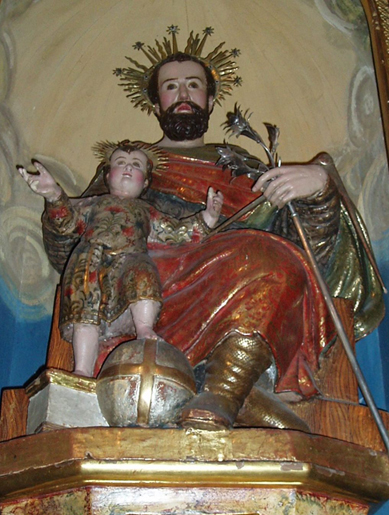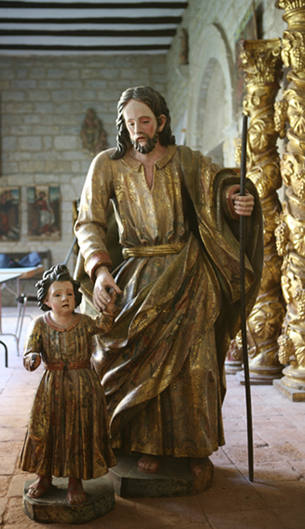The piece of the month of April 2009
GROUP SCULPTURE OF SAINT JOSEPH AND THE CHILD. DIOCESAN MUSEUM. CATHEDRAL OF PAMPLONA
Eduardo Morales Solchaga
Chairof Navarrese Heritage and Art
The guilds and brotherhoods, materially and spiritually impoverished institutions since the end of the Modern Age, invested in a special way their wealth in the configuration of their altars, in which their titular saints shone with their own light, whose function not only remained in the presidency of the same, but sometimes went beyond the confraternity chapels, either to contribute to the magnificence of the ceremonies that took place in the temples that housed them, or to go out in procession through the streets of the towns and cities where they were located. The sculptural group studied here belonged to the brotherhood of St. Joseph and St. Thomas of the Lignar Arts of Pamplona, based in the cathedral of Pamplona.
To understand its realization it is necessary to go back to the end of the 18th century. In 1775 the cathedral chapter learned of the brotherhood's intentions to carve a new effigy of St. Joseph, in order to place it on the main altar of the cathedral on the feast day of the patron saint. Until then, the primitive sculptural group that had presided over the altarpiece since the second third of the 16th century, masterfully executed by Miguel de Espinal I and financed with the alms of the members of the brotherhood, was taken to the altarpiece and processional image. With the execution of the carving, a solution was given to a problem that had been dragging on since the beginning of the XVII century, when according to an opinion of graduate Lusa, it was established that the sung mass of the main festivity should be performed on the main altar of the cathedral, moving the statue of St. Joseph to it, a task for which the clergymen who did it were rewarded a real in concept of gratification. The problem probably emanated from the inconvenience caused by the aforementioned transfer, since the excessive weight was added to the progressive deterioration of the image, a direct consequence of the usual internship, and the risk that at any given moment it could fall.

"St. Joseph with Child", by Miguel de Espinal I (c. 1560).
Returning to the end of the seventeenth century, on February 20, 1775 the proposal of the confraternities was examined in an auto del cabildo, being conveniently recorded in the book of agreements: "The Prior proposed that the confraternity of the Carpenters, represented to the Very Illustrious Chapter that because the image of St. Joseph is of great bulk and weight, which from its Altar it has been customary until now to transfer it to the Altar Table of the Altar of the Main Chapel of the Holy Church, for the feast and function of the Glorious Saint Joseph that the brotherhood celebrates on the day of his feast, several times they have been at risk of some misfortune, and to avoid it in the future they have thought of building at their own expense another image of the Saint, more manageable and guide, and use it for the aforementioned function". Therefore, they asked licence to the chapter to be able to build a new sculpture, so that the one they had been moving since the beginning of the 17th century would not be in danger. Naturally the chapter, as it did not suppose a expense for their coffers and contribute to the pomp of the festivity of the holy carpenter, agreed and the governmental board of the brotherhood decided to commission the sculpture group presented here.
The carving was made by Manuel Martín de Hontañón, for which he received 280 reales. The gilding and stew of the group was left to position by Juan Martín Andrés, who was paid 80 reales for his work work. Both artisans, among the most prestigious of the Pamplona focus at that time, were pressed to finish the order as soon as possible, so that at least it would be done for the next celebration, something that must have happened, because the following year a box was ordered to house the sculpture, with its door, locks and palm trees, which was executed by Martín Osés, master carpenter of the capital and brotherhood, for 35 reals, although today it has not been preserved.

"Saint Joseph with Child", by Manuel Martín de Hontañón (c. 1775).
The sculptural group , preserved today in the warehouses of the Diocesan Museum, located in the cathedral itself, follows the iconography popularized in the Castilian workshops of the first half of the seventeenth century, with Saint Joseph holding the child by the hand, although with the restraint typical of the academic works of the aforementioned Manuel Martín de Hontañón. On the other hand, the polychromy is sample very baroque (with gold, flowers and rocailles), as opposed to the smooth polychromy of the courtly images. The sculptural group is made up of two free-standing sculptures, of good size, that intertwined form the peaceful scene. The image remained in the house of the prior of the brotherhood all year round, until the day of the saint's feast day, something similar to what happened in the analogous brotherhood of San Sebastian, where the Veróiz family guarded the images of Jesus, Mary and Joseph, until the day of the Slavery, when they were taken out in procession.
Judging by the preserved testimonies, both images, both the one seated in the altarpiece, as well as the one kept in the prior's house, were endowed with indulgences by the bishop, don Severo Leonardo Adriani y Escofet: "In addition, the bishop has increased the indulgence of forty days to all the faithful who pray an Our Father and a Hail Mary before the image that is venerated on the altar of his name... and another forty praying the Our Father and Hail Mary before the image of the same saint that is preserved in the prior's house."
Documentation and bibliography
- file of the Cathedral of Pamplona, Agreements of the chapter.
- file Municipal of Pamplona, Guilds and brotherhoods, Brotherhood of St. Joseph and St. Thomas of Pamplona, Account books.
- ARAGÓN RUANO, A., "La cofradía de los gloriosos patriarcas San José y San Andrés de Carpinteros, toneleros y canteros de San Sebastián: un ejemplo de oligarquización (siglos XVI al XVIII)", bulletin de programs of study Históricos de San Sebastián, nº 37 (2004), pp. 36 - 61.
- FERNÁNDEZ GRACIA, R., El retablo Barroco en Navarra, Pamplona, Government of Navarra, 2002.
